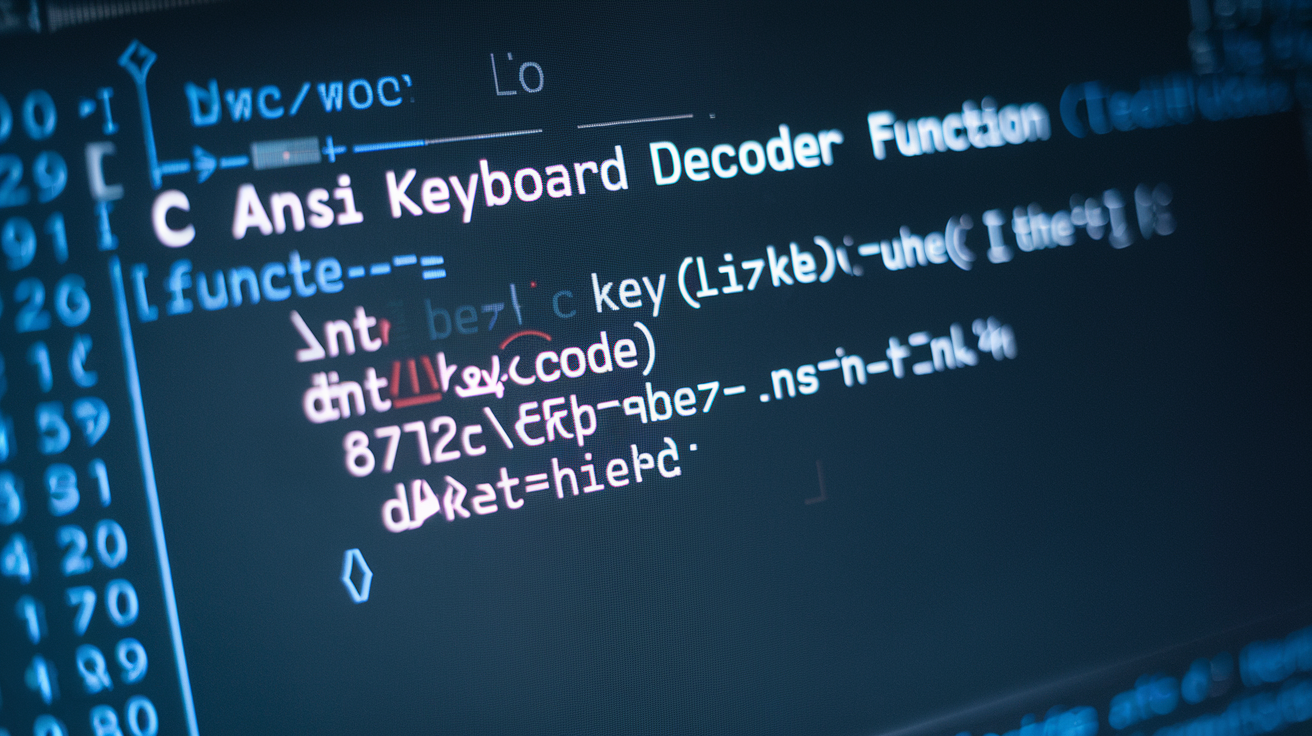The C ANSI keyboard decoder function is essential in interpreting keyboard input in embedded systems and applications. It translates keycodes from the keyboard into characters or actions using the ANSI encoding standard. This article covers the function’s importance, how it works, and its implementation.
What is the C ANSI Keyboard Decoder Function?
The C ANSI keyboard decoder function processes critical presses from a keyboard, converting the keycodes into readable characters or control codes based on the ANSI encoding system. ANSI defines characters like letters, numbers, and special symbols, allowing the system to decode user input effectively.
How Does It Work?
When a key is pressed, the keyboard generates a keycode, which the decoder function translates into the corresponding character. For example, pressing the “A” key (keycode 65) will map to the character “A.” The decoder can also process control keys (e.g., “Enter”) and modifier keys (e.g., “Shift”).
The Role of ANSI Encoding
ANSI encoding plays a pivotal role in the C ANSI keyboard decoder function. The ANSI standard defines a specific set of characters and control codes for keyboard inputs. The keycode received is mapped to a corresponding ANSI character or control code in the C ANSI keyboard decoder function.
For example, if the user presses the “A” key, the system sends a keycode, which the decoder maps to the ASCII value of 65, returning the character “A.” Similarly, the decoder maps this to the interrupt signal if a control key such as “Ctrl+C” is pressed.
Why is It Important?
The system couldn’t interpret keypresses correctly without the C ANSI keyboard decoder function. This function is essential for applications requiring accurate Text input, such as terminal emulators, Text editors, and interactive systems.
Basic Implementation
Here’s a simple implementation of the C ANSI keyboard decoder function:
#include <stdio.h>
char decode_key(int keycode) {char ansi_table[256] = { [65] = ‘A’, [66] = ‘B’ }; // Simplified mapping return (keycode < 0 || keycode >= 256) ? ‘\0’ :ansi_table[keycode];}int main() {int keycode = 65; // ‘A’ key
printf(“Decoded key: %c\n”, decode_key(keycode)); // Output: ‘A’return 0;}
This function maps keycodes to characters based on a predefined table. It can be expanded to include all keys.
Handling Special Keys
The C ANSI keyboard decoder function also processes non-printable keys, such as “Enter,” “Tab,” and modifier keys. For example, pressing “Enter” may return a newline character (\n), and “Ctrl+C” could trigger an interrupt.
Challenges in Implementation
The main challenge is handling different keyboard layouts, such as QWERTY and AZERTY. Keycodes may vary depending on the design, so the function needs to account for this when decoding input.
Optimization Tips
Performance is essential, especially in systems with limited resources. One way to optimize the C ANSI keyboard decoder function is by minimizing the lookup time for keycodes. Instead of using a simple array, developers can use more advanced data structures, such as hash maps or binary search trees, which allow for faster keycode-to-character lookups.
Another optimization approach is to cache frequently used keycodes or characters, reducing the need for redundant lookups.
Security Considerations
Ensure secure handling of keycodes to prevent malicious software, such as keyloggers, from intercepting sensitive input. Input encryption and validation can add an extra layer of protection.
Testing the Function
Thorough testing ensures the decoder works across various platforms and with different keyboard layouts. Automated trying out can help streamline this method.
Real-World Applications of the C ANSI Keyboard Decoder Function
The C ANSI keyboard decoder function has several real-world applications. A number of the maximum extremely good use cases include:
Terminal Emulators: These programs allow users to interact with remote systems using text-based input. The decoder translates keypresses into the appropriate characters, enabling a smooth user experience.
Text Editors: Text editors like Vim or Emacs rely on accurate keyboard input handling. The C ANSI keyboard decoder function ensures that each keypress is correctly interpreted and reflected in the Text editor.
Games: Many interactive games use keyboard input for player actions. The decoder function maps keypresses to game actions like movement or firing weapons.
Embedded Systems: Microcontrollers may use keyboards to collect user input in embedded systems. The decoder function ensures that this input is processed correctly.
Handling Multiple Keyboard Layouts
Different layouts, like QWERTY and Dvorak, require the decoder to adapt its keycode mappings to ensure consistent input interpretation across layouts.
Future Developments
The function will evolve to support newer encodings, better handling of special keys, and more keyboard layouts. Advanced systems may also integrate Unicode support for a broader range of characters.
Conclusion
In conclusion, the C ANSI keyboard decoder function is a powerful tool for interpreting keyboard input in C programming. By understanding its principles and implementing them effectively, developers can ensure systems process keyboard input accurately and efficiently. Whether building terminal emulators, Text editors, or embedded systems, mastering the C ANSI keyboard decoder function is essential for creating seamless and responsive applications.
FAQs
1. What is the purpose of the C ANSI keyboard decoder function?
It decodes keycodes from a keyboard and maps them to characters or actions according to the ANSI standard.
2. How does the C ANSI keyboard decoder function work?
It receives a keycode, looks it up in an ANSI table, and returns the corresponding character or control code.
3. What are some challenges using the C ANSI keyboard decoder function?
Challenges include handling different keyboard layouts and ensuring compatibility with various systems.
4. Can the C ANSI keyboard decoder function handle special keys?
Yes, it can process special keys like “Enter,” “Ctrl,” and “Alt,” mapping them to control codes or specific actions.
5. Why is testing necessary for the C ANSI keyboard decoder function?
Testing ensures the function works correctly across different platforms, keyboards, and layouts, ensuring accurate input processing.
